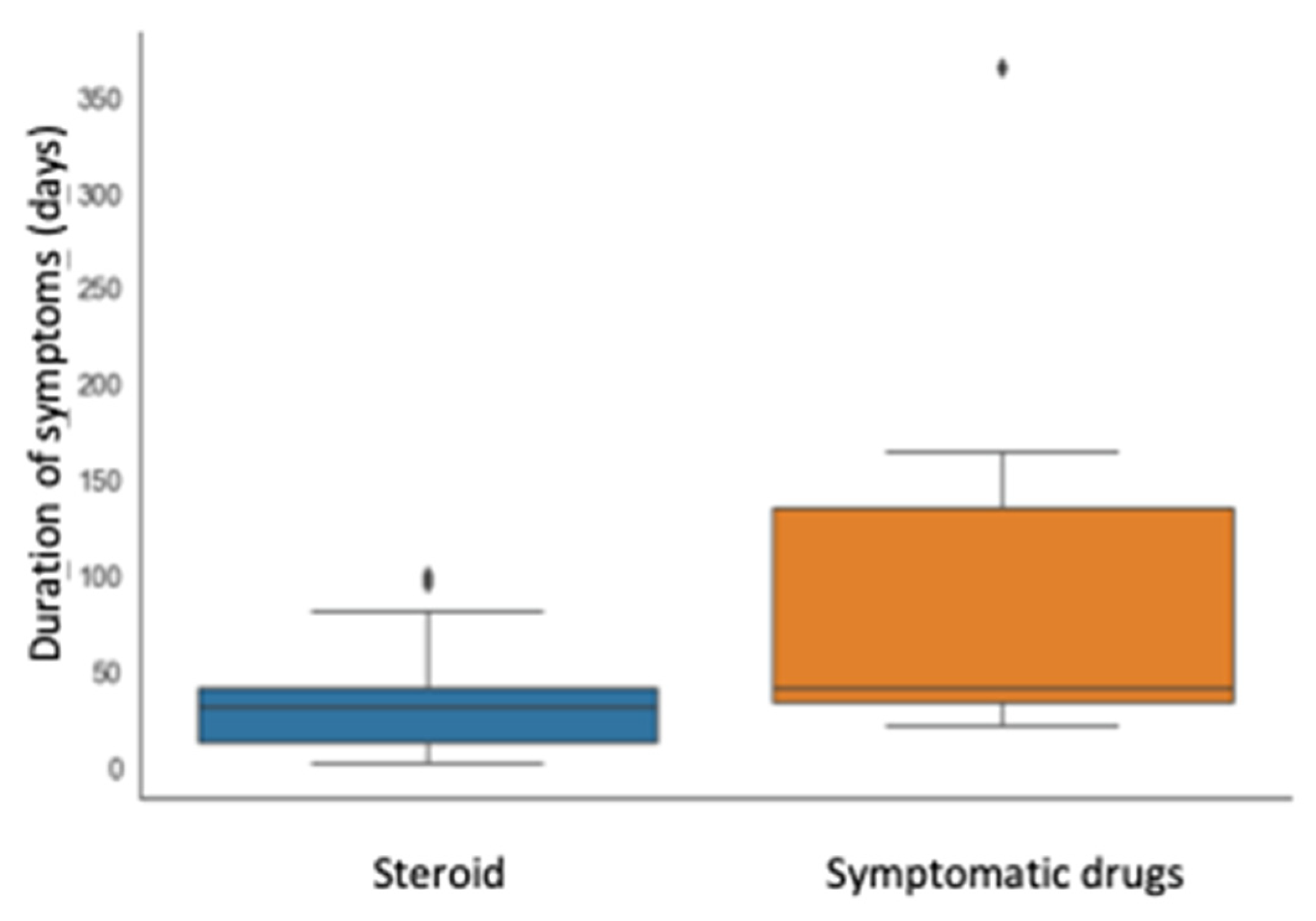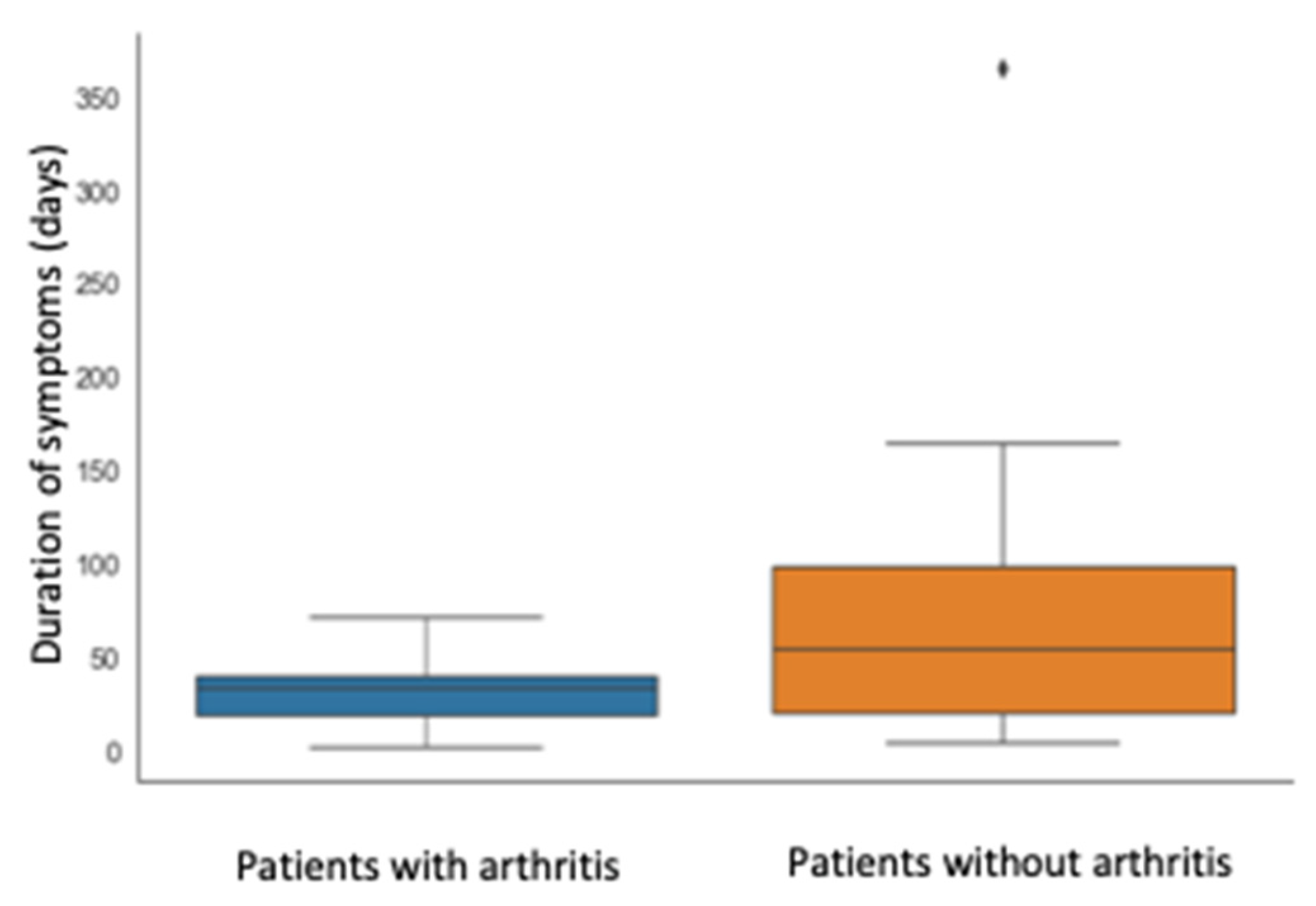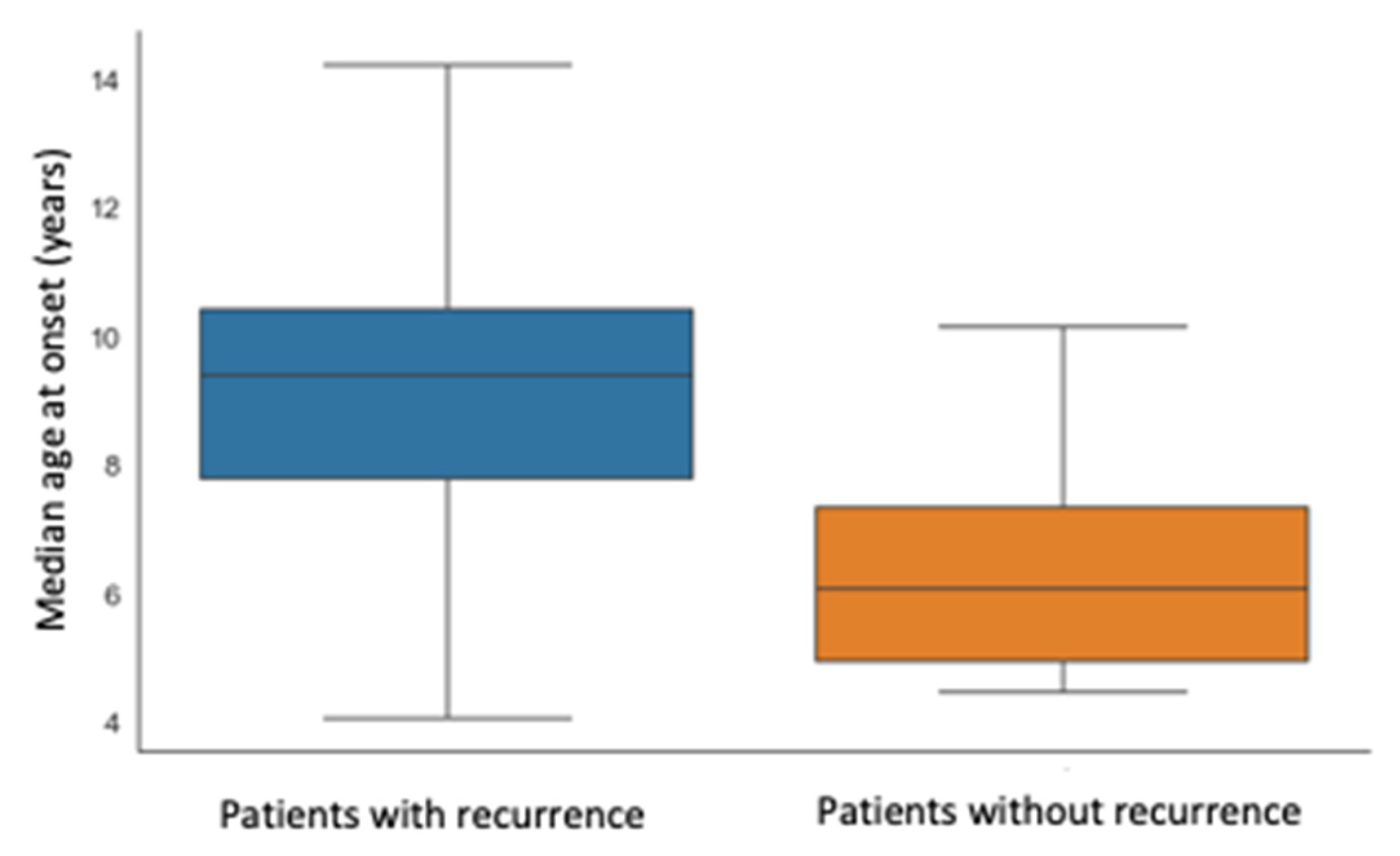Corticosteroid Treatment in Sydenham Chorea: A 27-Year Tertiary Referral Center Experience
Abstract
1. Introduction
2. Materials and Methods
Statistical Analysis
3. Results
4. Discussion
Author Contributions
Funding
Informed Consent Statement
Data Availability Statement
Acknowledgments
Conflicts of Interest
References
- Cardoso, F. Autoimmune choreas. J. Neurol. Neurosurg. Psychiatry 2017, 88, 412–417. [Google Scholar] [CrossRef] [PubMed]
- Yilmaz, S.; Mink, J.W. Treatment of Chorea in Childhood. Pediatr. Neurol. 2020, 102, 10–19. [Google Scholar] [CrossRef] [PubMed]
- Cardoso, F.; Eduardo, C.; Silva, A.P.; Mota, C.C.C. Chorea in fifty consecutive patients with rheumatic fever. Mov. Disord. 1997, 12, 701–703. [Google Scholar] [CrossRef] [PubMed]
- Nardocci, N.; Fernandez-Alvarez, E. Movement Disorders in Children: A Clinical Update with Video Recordings. In Movement Disorders in Children: A Clinical Update with Video Recordings; John Libbey Eurotext: Montrouge, France, 2007; pp. 113–124. [Google Scholar]
- Vasconcelos, L.P.B.; Vasconcelos, M.C.; Nunes, M.D.C.P.; Teixeira, A.L. Sydenham’s chorea: An update on pathophysiology, clinical features and management. Expert Opin. Orphan Drugs 2019, 7, 501–511. [Google Scholar] [CrossRef]
- Paz, J.A.; Silva, C.A.A.; Marques-Dias, M.J. Randomized Double-Blind Study With Prednisone in Sydenham’s Chorea. Pediatr. Neurol. 2006, 34, 264–269. [Google Scholar] [CrossRef]
- Swedo, S.E. Sydenham’s Chorea: A Model for Childhood Autoimmune Neuropsychiatric Disorders. JAMA 1994, 272, 1788–1791. [Google Scholar] [CrossRef]
- Garvey, M.A.; Snider, L.A.; Leitman, S.F.; Werden, R.; Swedo, S.E. Treatment of Sydenham’s chorea with intravenous immunoglobulin, plasma exchange, or prednisone. J. Child Neurol. 2005, 20, 424–429. [Google Scholar] [CrossRef]
- Walker, K.G.; Wilmshurst, J.M. An update on the treatment of Sydenham’s chorea: The evidence for established and evolving interventions. Ther. Adv. Neurol. Disord. 2010, 3, 301–309. [Google Scholar] [CrossRef]
- Guidelines for the Diagnosis of Rheumatic Fever: Jones Criteria, 1992 Update|JAMA|JAMA Network [Internet]. Available online: https://jamanetwork.com/journals/jama/article-abstract/400639 (accessed on 11 November 2022).
- Barsottini, O.G.; Ferraz, H.B.; Seviliano, M.M.; Barbieri, A. Brain SPECT imaging in Sydenham’s chorea. Braz. J. Med. Biol. Res. 2002, 35, 431–436. [Google Scholar] [CrossRef]
- Virtanen, P.; Gommers, R.; Oliphant, T.E.; Haberland, M.; Reddy, T.; Cournapeau, D.; Burovski, E.; Peterson, P.; Weckesser, W.; Bright, J.; et al. SciPy 1.0: Fundamental algorithms for scientific computing in Python. Nat. Methods 2020, 17, 261–272. [Google Scholar] [CrossRef]
- Favaretto, E.; Gortani, G.; Simonini, G.; Pastore, S.; Di Mascio, A.; Cimaz, R.; Taddio, A. Preliminary data on prednisone effectiveness in children with Sydenham chorea. Eur. J. Pediatr. 2020, 179, 993–997. [Google Scholar] [CrossRef]
- Barash, J.; Margalith, D.; Matitiau, A. Corticosteroid treatment in patients with Sydenham’s chorea. Pediatr. Neurol. 2005, 32, 205–207. [Google Scholar] [CrossRef]
- Dean, S.L.; Singer, H.S. Treatment of Sydenham’s Chorea: A Review of the Current Evidence. Tremor Other Hyperkinetic Mov. 2017, 7, 456. [Google Scholar] [CrossRef]
- Teixeira, A.L. Sydenham’s chorea may be a risk factor for drug induced parkinsonism. J. Neurol. Neurosurg. Psychiatry 2003, 74, 1350–1351. [Google Scholar] [CrossRef]
- Korn-Lubetzki, I.; Brand, A.; Steiner, I. Recurrence of Sydenham chorea: Implications for pathogenesis. Arch. Neurol. 2004, 61, 1261–1264. [Google Scholar] [CrossRef]
- Demiroren, K.; Yavuz, H.; Cam, L.; Oran, B.; Karaaslan, S.; Demiroren, S. Sydenham’s Chorea: A Clinical Follow-Up of 65 Patients. J. Child Neurol. 2007, 22, 550–554. [Google Scholar] [CrossRef]
- Tumas, V.; Caldas, C.T.; Santos, A.C.; Nobre, A.; Fernandes, R.M.F. Sydenham’s chorea: Clinical observations from a Brazilian movement disorder clinic. Park. Relat. Disord. 2007, 13, 276–283. [Google Scholar] [CrossRef]
- Kılıç, A.; Ünüvar, E.; Tatlı, B.; Gökçe, M.; Ömeroğlu, R.E.; Oğuz, F.; Sıdal, M. Neurologic and Cardiac Findings in Children With Sydenham Chorea. Pediatr. Neurol. 2007, 36, 159–164. [Google Scholar] [CrossRef]
- Gurkas, E.; Karalok, Z.S.; Taskin, B.D.; Aydogmus, U.; Guven, A.; Degerliyurt, A.; Bektas, O.; Yilmaz, C. Predictors of recurrence in Sydenham’s chorea: Clinical observation from a single center. Brain Dev. 2016, 38, 827–834. [Google Scholar] [CrossRef]
- al-Eissa, A. Sydenham’s chorea: A new look at an old disease. Br. J. Clin. Pract. 1993, 47, 14–16. [Google Scholar]
- Gebremariam, A. Sydenham’s chorea: Risk factors and the role of prophylactic benzathine penicillin G in preventing recurrence. Ann. Trop. Paediatr. 1999, 19, 161–165. [Google Scholar] [CrossRef] [PubMed]
- Berrios, X.; Quesney, F.; Morales, A.; Blazquez, J.; Bisno, A.L. Are all recurrences of “pure” Sydenham chorea true recurrences of acute rheumatic fever? J. Pediatr. 1985, 107, 867–872. [Google Scholar] [CrossRef] [PubMed]
- Manyemba, J.; Mayosi, B.M. Penicillin for secondary prevention of rheumatic fever. Cochrane Database Syst. Rev. 2002, CD002227. [Google Scholar] [CrossRef] [PubMed]
- Moreira, J.; Kummer, A.; Harsányi, E.; Cardoso, F. Psychiatric disorders in persistent and remitted Sydenham’s chorea. Park. Relat. Disord. 2014, 20, 233–236. [Google Scholar] [CrossRef]
- Cappellari, A.M.; Lanfranchi, C.; Bruschi, G.; Petaccia, A. Sydenham’s chorea: A diagnosis not to miss. Rev. Neurol. 2022, 178, 855–856. [Google Scholar] [CrossRef]



| Demographic Characteristics | All Patients with SC (59) | Patients Treated with Prednisone (39) | Patients Treated with Symptomatic Drugs (10) |
|---|---|---|---|
| Median age (IQR) | 9.3 years (3.2 years) | 9.3 years (3.4 years) | 8.2 years (1.8 years) |
| Sex | Female 44 (75%) Male 15 (25%) | Female 26 (66%) Male 13 (33%) | Female 10 (100%) Male 0 (0%) |
| Ethnic group | Caucasian 56 (95%) South American 3 (5%) | Caucasian 37 (95%) South American 2 (5%) | Caucasian 9 (90%) South American 1 (10%) |
| Clinical features | |||
| Familiarity for RF | Positive 5 (8.4%) | Positive 3 (7.6%) | Positive 0 (0%) |
| Previous pharyngotonsillitis | Yes 38 (64.4%) No 19 (35.3%) Not available 2 (0.03%) | Yes 27 (69%) No 11 (28%) Not available 1 (3%) | Yes 7 (70%) No 3 (30%) Not available 2 (0.03%) |
| Throat culture at SC onset | Positive 15 (25.4%) Negative 31 (52.5%) Not done 13 (22%) | Positive 22 (56%) Negative 11 (28%) Not done 6 (16%) | Positive 6 (60%) Negative 3 (30%) Not done 1 (10%) |
| Hospitalization | No 8 (13.6%) Yes 51 (86.4%) Mean Time (days): 10.5 | No 2 (5%) Yes 37 (95%) Mean Time (days): 19.7 | No 7 (70%) Yes 30 (30%) Mean Time (days): 9.5 |
| ASO titer (UI/mL) | 957 (IQR: 1030) | 966 (IQR: 1196) | 1199 (IQR:268) |
| Arthritis | 14 (24%) | 11 (28%) | 3 (30%) |
| Carditis | No 9 (15.3%) Yes 50 (84.7%), of which: One valve involved 37 (74%) Two valves involved 13 (26%) | No 3 (8%) Yes 36 (92%), of which: One valve involved 24 (66%) Two valves involved 12 (33%) | No 2 (20%) Yes 8 (80%), of which: One valve involved 7 (88%) Two valves involved 1 (12%) |
| Subcutaneous nodules | 1 (0.02%) | 1 (0.03%) | 0 (0%) |
| Erythema marginatum | 1 (0.02%) | 0 (0%) | 1 (10%) |
| Neuropsychiatric symptoms | 14 (23%) | 8 (20%) | 2 (20%) |
| Hemichorea | 14 (23%) | 11 (28%) | 1 (10%) |
| Irregular secondary prophylaxis for GABHS | 4 (6%) | 3 (77%) | 1 (10%) |
| Patients Treated with Prednisone (39) | Patients Treated with Symptomatic Drugs (10) | p-Value | |
|---|---|---|---|
| Time for improvement (IQR) | 1 day | 2 days | 0.149 |
| (1–3) | (1–8) | ||
| Time for remission (IQR) | 31 days | 41 days | 0.023 |
| (13–41) | (33–135) | ||
| Recurrence rate (%) | 6 out of 39 | 0 | 0.433 |
| (15.4%) | (0%) |
| Demographic Characteristics | Patients with Arthritis (14) | Patients without Arthritis (35) |
|---|---|---|
| Median age (IQR) | 8.5 years (2.6 years) | 9.3 years (3.2 years) |
| Sex | Female 10 (71%) Male 4 (29%) | Female 26 (74%) Male 9 (26%) |
| Ethnic group | Caucasian 12 (86%) South American 2 (14%) | Caucasian 33 (94%) South American 2 (6%) |
| Clinical features | ||
| Familiarity for RF | Positive 0 (0%) | Positive 3 (8%) |
| Previous pharyngotonsillitis | Yes 12 (86%) No 2 (14%) Not available 0 (0%) | Yes 22 (63%) No 12 (34%) Not available 1 (3%) |
| Throat culture at SC onset | Positive 3 (21.5%) Negative 8 (57%) Not done 3 (21.5%) | Positive 9 (26%) Negative 20(57%) Not done 6 (17%) |
| Hospitalization | No 2 (14%) Yes 14 (86%) Mean Time (days): 12.2 | No 3 (8%) Yes 32 (92%) Mean Time (days): 20.4 |
| ASO titer (UI/mL) | 1301.5 (IQR: 1165) | 975 (IQR: 1128.5) |
| Carditis | No 1 (7%) Yes 13 (93%), of which: One valve involved: 10 (77%) Two valves involved: 3 (23%) | No 4 (11%) Yes 31 (89%), of which: One valve involved 7 (68%) Two valves involved 1 (32%) |
| Subcutaneous nodules | 1 (21%) | 0 (0%) |
| Erythema marginatum | 1 (21%) | 0 (0%) |
| Neuropsychiatric symptoms | 3 (21.5%) | 7 (20%) |
| Hemichorea | 4 (26%) | 8 (23%) |
| Irregular secondary prophylaxis for GABHS | 12 (86%) | 33 (94%) |
| Therapy | Prednisone 11 (79%) Symptomatic drugs 3 (21%) | Prednisone 28 (80%) Symptomatic drugs 7 (20%) |
Disclaimer/Publisher’s Note: The statements, opinions and data contained in all publications are solely those of the individual author(s) and contributor(s) and not of MDPI and/or the editor(s). MDPI and/or the editor(s) disclaim responsibility for any injury to people or property resulting from any ideas, methods, instructions or products referred to in the content. |
© 2023 by the authors. Licensee MDPI, Basel, Switzerland. This article is an open access article distributed under the terms and conditions of the Creative Commons Attribution (CC BY) license (https://creativecommons.org/licenses/by/4.0/).
Share and Cite
Cappellari, A.M.; Rogani, G.; Filocamo, G.; Petaccia, A. Corticosteroid Treatment in Sydenham Chorea: A 27-Year Tertiary Referral Center Experience. Children 2023, 10, 262. https://doi.org/10.3390/children10020262
Cappellari AM, Rogani G, Filocamo G, Petaccia A. Corticosteroid Treatment in Sydenham Chorea: A 27-Year Tertiary Referral Center Experience. Children. 2023; 10(2):262. https://doi.org/10.3390/children10020262
Chicago/Turabian StyleCappellari, Alberto Maria, Greta Rogani, Giovanni Filocamo, and Antonella Petaccia. 2023. "Corticosteroid Treatment in Sydenham Chorea: A 27-Year Tertiary Referral Center Experience" Children 10, no. 2: 262. https://doi.org/10.3390/children10020262
APA StyleCappellari, A. M., Rogani, G., Filocamo, G., & Petaccia, A. (2023). Corticosteroid Treatment in Sydenham Chorea: A 27-Year Tertiary Referral Center Experience. Children, 10(2), 262. https://doi.org/10.3390/children10020262





